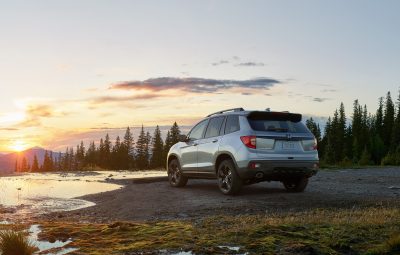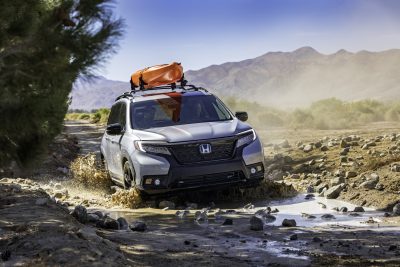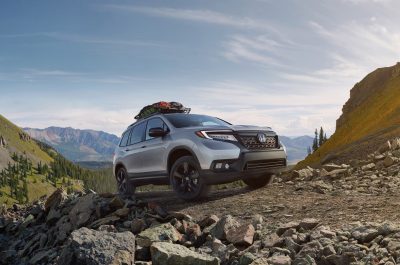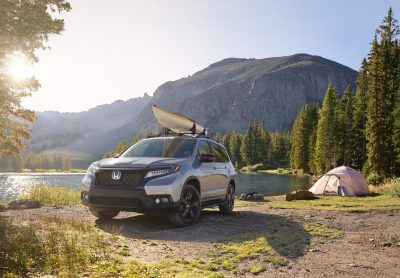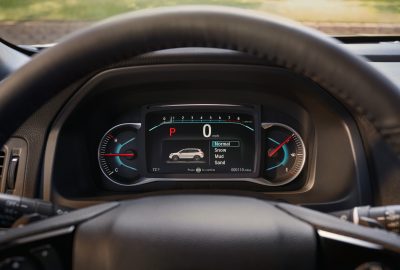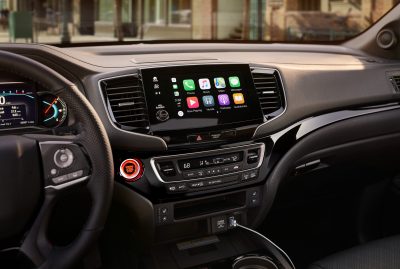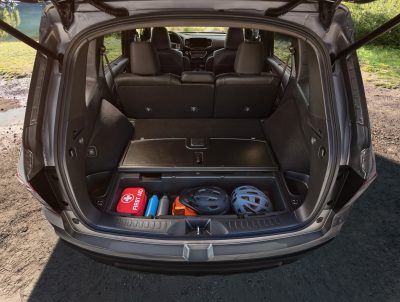Honda is a company of many talents, but the one thing it lacked for the longest time was a proper mid-size two row crossover to slot between the CR-V and the larger Pilot SUV. The Japanese auto giant has punched its figurative passport so to speak, and has unveiled the model that will take it to this vaunted chunk of the CUV progress, the 2019 Honda Passport.
At first glance, the Passport is indeed what it appears to be, a shrunken Honda Pilot, with the distinctively Pilot themed nose adding to that theme. However, the stance is perkier, and lacks a lot of the more mundane elements that define the Pilot. With the Passport targeting rivals such as the Ford Edge, Nisan Murano, and even the Jeep Grand Cherokee, the Passport thankfully ignores the themes generated by the first two, and instead embodies some of the Jeep’s mojo in wearing a decidedly off-road capable suit of clothes. This is an indirect homage to its ancestor’s Rodeo heritage, and a lot of the design consists of blocky shapes, black cladding, as well as slightly meatier tires to tackle whatever soft road trail that the Passport finds its way onto. These attributes give it more of a youthful vibe than the doughy Pilot, and should allow the Passport to appeal to younger buyers. Rounding out the changes are unique taillights, as well as a slightly altered rear fascia to further differentiate itself from big brother.
At its core, the Passport is nothing more than a shrunken Pilot, with both SUVs sharing the same 110 inch wheelbase. Much of the 6.5 inches of length that Honda engineers cleaved off was on the Pilot’s rear overhang, which in turn caused the third row seat to be removed. These changes are what separate the two the most versus any extensive engineering tricks or an all new platform. Some folks might cry foul and accuse Honda of lazy engineering, but with the development of a new platform being rather expensive, we will give Honda props for using a cost effective alternative when the time came to put all the pieces for the Passport into place.
As for Honda, they will point out that the Passport has more off-road capability than the Pilot with the 7.8 inches of ground clearance being slightly better than the 7.3 inches wielded by the Pilot. The approach and departure angles are also slightly improved, but those thinking that the Passport will copy its ancestor’s capability in this arena will be very disappointed. The Passport is a car based CUV that eschews the original’s body on frame layout, and all-wheel drive is not even standard equipment. The system that is available is the same unit that is also used in both the Pilot, and the Ridgeline pickup. Dubbed i-VTM4 (Intelligent Variable Torque Management) this particular system features the expected Normal, Sand, Mud, and Snow drive settings, but is also capable of using the brakes to help direct torque to where it is needed. This solution eliminates the added weight, simplifies assembly, and eliminates a lot of the cost that is associated with a traditional torque-vectoring system. A two speed transfer case is not available, and all season tires are the sole fare on all Passports. We are hoping to spend some time with a Passport on an off-road course in the future to see if it can still deliver on its off-road oriented mission or not despite its lack of more off-road ready hardware.
Performance for the Passport also comes from the Pilot, with a 3.5 liter V6 being the sole engine (versus our initial theory of a four cylinder base engine.) The engine is still capable of delivering a stout 280 horsepower, but the transmission is the nine speed unit seen in higher Pilot models versus the one seen in lesser Pilot variants. This is on par with the 3.6 liter Pentastar V6 in the Jeep, but it does lose ground to the turbocharged engines that can be equipped to the Edge. Cargo capacity has not been sacrificed for size, with the Passport still capable of hauling 41 cubic feet of stuff with the seats up, and 78 inches with the seats folded down. This is six inches less than the bigger Pilot, but completely crushes the Jeep and its 36 and 68 cubic foot capacities, as well as the Ford Edge and its own 39 and 73 capabilities.
The interior of the Passport may cause you to do a bit of a double take at first glance, with many folks thinking that they have set foot inside of a Pilot. Indeed, the steering wheel, seats, dashboard, and center console are all lifted directly from the Pilot, with the touchscreen infotainment system also lifted from the fore-mentioned Pilot. Like before, it features a physical volume knob, but sadly, the system does not adopt the redundant buttons that Honda has equipped to systems in a few of its other offerings i.e the Honda Accord sedan. It’s a shame, since these buttons do improve ease of use, and also greatly reduce the amount of fingerprints that end up on the screen. Base Sport models use a smaller non-touch radio that delivers a more analog listening experience and it also features a physical knob for tuning the radio.
Beyond the fore-mentioned Sport model, Honda will also offer the Passport in EX-L, Touring and Elite trims, with front wheel drive being standard fare for the first three trims. Elite models on the other hand flip the script, and come equipped with standard all-wheel drive as well as bigger tires. All Passports arrive equipped with Honda’s Sensing suite of safety features. These include adaptive cruise control, automated emergency braking, forward collision warning, and lane departure warning software. Full LED lighting is standard issue along with push button start, keyless entry, a 215 watt six speaker sound system, and tri-zone climate control. Higher trims bring a more potent stereo system into the mix, as well as blind spot monitoring, leather seats, a mobile WiFi hotspot, sunroof, power tailgate, and so much more. Honda will also have two different design packages available for the Passport, with either an Urban theme, or the featured Adventure package that includes a roof rack, side steps, and accompanying basket.
Pricing information is forthcoming, but look for the Passport to have a base price that doesn’t stray too far from the base $32,445 Pilot LX, with this figure possibly being a bit higher due to the Passport’s more extensive suite of standard equipment. Expect sales to begin next year, with more detailed launch information being released after its debut in L.A.

Carl Malek has been an automotive journalist for over 10 years. First starting out as a freelance photographer before making the transition to writing during college, his work has appeared on numerous automotive forums as well as websites such as Autoshopper.com.
Carl is also a big fan of British vehicles with the bulk of his devotion going to the Morgan Motor Company as well as offerings from Lotus, MG, and Caterham. When he is not writing about automobiles, Carl enjoys spending time with his family and friends in the Metro Detroit area, as well as spending time with his adorable pets.


